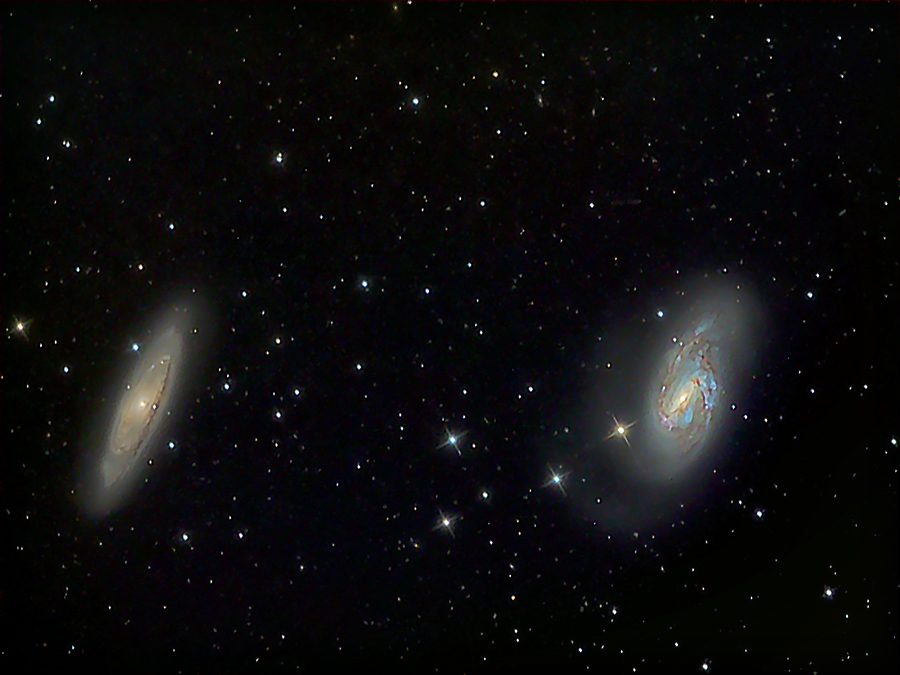M65 (w/SN2013am) & M66
2h55m luminance, 15m each RGB, in 300s subs
AT10RC, SBIG ST2000XM, Baader filters
Look at the geometry of the obliquely presented spiral. The most prominent spiral arm's dust is silhouetted, so it must be in the foreground. Follow it around to SN2013am's location on its inner edge. It's plain that the supernova is on the far side of the galaxy, and its light is shining through a lot of the same dust and gas that renders the galaxy so red. That's probably why this supernova is so faint. It's down around Mv 16.3 or so. It "ought" to be at least 5-10x brighter than this if distance were the only factor. Compare ruddy M65 to M66 with its bright blue arms dominated by young stars seen through comparatively little dust. And while you're looking at M66, note the faint spray (especially below and to the left) of stars pulled away by tides during encounters with its neighbor.
There's a faint trail -- two celestial em dashes just to the right of a semi-prominent field star above M66. It's best seen in the large version of the PixInsight image below. I think it was collected during L-exposures (Maxim distributes RGB collection throughout the imaging session). Guide 9 does not show an asteroid in the vicinity, and it's much too bright to be unknown. This field is way too far north of the geosynch satellite belt for it to be "one of ours" so I'm a bit puzzled by what produced this.
While waiting for the Trio to clear the pines, I spent some time on M81. It's big, bright, and full of lovely detail. Images to come (scroll down). Guiding tonight was superb: RMS errors of .15 to .20 pixels in each axis were typical with maximum excursions of .5 to .6 pixels (I was using 5 and 10 second guiding iterations on tenth magnitude stars). Sub-arcsecond guiding, that's the ticket.
PixInsight is a feature-rich software package for astronomical image processing with a reputation for a daunting interface and unintuitive workflow. The demo images and many live examples from the web suggest it's worth figuring out. I downloaded a trial copy and used it to suppress noise, deconvolve (while suppressing ringing), and stretch the left side of the histogram of the M65 / M66 image. My starting point was the stacked and calibrated output from MaximDL, and I finished in Photoshop. The result goes noticeably deeper and fine detail is finer (albeit a little harsher). With experience, I am 100% certain that this can be done better and that more (perhaps all or almost all) of these steps can be done wtihin PixInsight. Behold:

04/10/2013: Here's M81, a "grand design" spiral in Ursa Major, color from April 5-6, luminance from tonight. It's still only 2h15m exposure in L. I'd like more like 10 or 12 hours:

M81
9x900s Luminance, 4x300s RGB
(the usual workflow)
(There's a better, later version on the next page.)
Worth noting: the temperature last night was in the 70'sF. This caused two problems: I could only cool the chip to -25°C, and my shortest focal length configuration, the one I've been using most often for deep-sky photos, would not reach focus. Minus 25 will do, but most of my calibration files are set up for a chip temperature five degrees cooler (it's enough to matter). And as for the focal point, at my mininum effective focal length (1210mm), the ST2000 focuses only ~40 Robofocus steps out from the full-in position. Thermal expansion somewhere in the system blocked me out of that preferred EFL. I removed the two 17mm Hyperion extension rings between the AP67CCD reducer and the ST2000 snout and had plenty of room to spare (Pinpoint Astrometry says this configuration produces an EFL of 1,409mm @ F5.5 with a plate scale of 1.08 arc seconds per pixel). I can easily put one extension back in place (I would've only removed one, but they were stuck). Using both in summer temperatures may require me to use the lathe to whittle something in the adapter stack down a few hundredths. After that calamity, I refocused using a Bahtinov mask which worked quickly and well (why don't you do this more often?). Guiding with the Mach1 continues to be dead on: corrections until the sky closed down with high clouds were 0.2 pixels RMS in both X and Y using 10 second integrations.
Except where noted, deep-sky photos are made with an SBIG ST2000XM CCD behind a 10-inch Astro-Tech Ritchey-Chretien carried on an Astro-Physics Mach1GTO. The CCD is equipped with Baader LRGB and 7nm H-a filters. The internal guide chip of the CCD most often keeps the OTA pointed in the right direction (I'll let you know when a Meade DSI and a separate OAG or guidescope takes its place). Camera control and guiding are handled by Maxim DL 5.12. The stock focuser on the AT10RC has been augmented with Robofocus 3.0.9 using adapters turned on the lathe downstairs. Maxim performs image calibration, alignment, and stacking; Photoshop CS4 and FocusMagic 3.0.2 take it from there. Gradient Xterminator by Russell Croman and Astronomy Tools by Noel Carboni see their share of work, too. Beginning in May 2013, PixInsight has taken over some of the heavy lifting for transfer function modification and deconvolution.